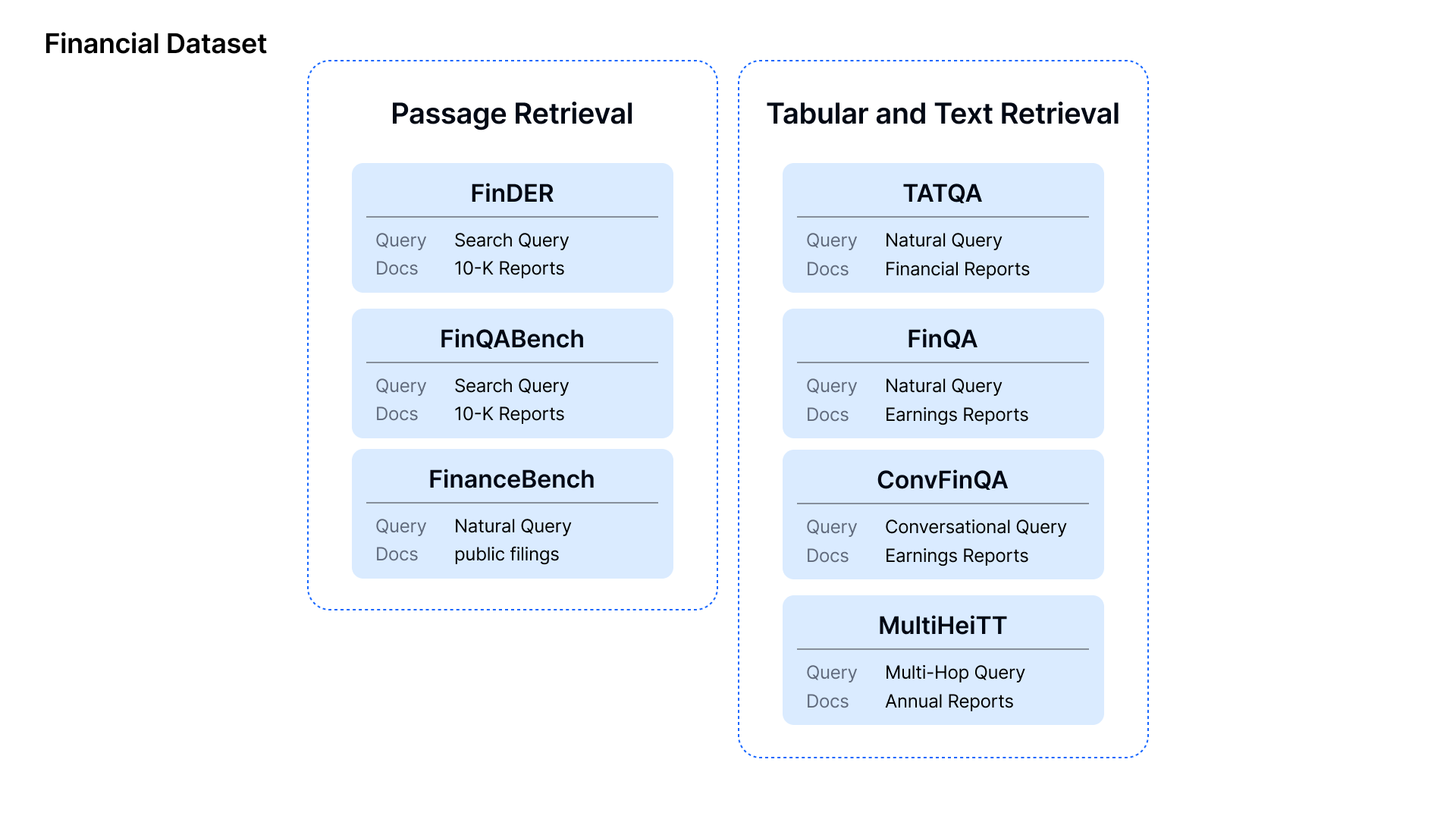|
--- |
|
language: |
|
- en |
|
license: mit |
|
configs: |
|
- config_name: FinDER |
|
data_files: |
|
- split: corpus |
|
path: FinDER/corpus.jsonl.gz |
|
- split: queries |
|
path: FinDER/queries.jsonl.gz |
|
- config_name: ConvFinQA |
|
data_files: |
|
- split: corpus |
|
path: ConvFinQA/corpus.jsonl.gz |
|
- split: queries |
|
path: ConvFinQA/queries.jsonl.gz |
|
- config_name: FinQA |
|
data_files: |
|
- split: corpus |
|
path: FinQA/corpus.jsonl.gz |
|
- split: queries |
|
path: FinQA/queries.jsonl.gz |
|
- config_name: FinQABench |
|
data_files: |
|
- split: corpus |
|
path: FinQABench/corpus.jsonl.gz |
|
- split: queries |
|
path: FinQABench/queries.jsonl.gz |
|
- config_name: FinanceBench |
|
data_files: |
|
- split: corpus |
|
path: FinanceBench/corpus.jsonl.gz |
|
- split: queries |
|
path: FinanceBench/queries.jsonl.gz |
|
- config_name: MultiHiertt |
|
data_files: |
|
- split: corpus |
|
path: MultiHeirtt/corpus.jsonl.gz |
|
- split: queries |
|
path: MultiHeirtt/queries.jsonl.gz |
|
- config_name: TATQA |
|
data_files: |
|
- split: corpus |
|
path: TATQA/corpus.jsonl.gz |
|
- split: queries |
|
path: TATQA/queries.jsonl.gz |
|
--- |
|
# Dataset Card for FinanceRAG |
|
|
|
## Dataset Summary |
|
|
|
The detailed description of dataset and reference will be added after the competition in [Kaggle/FinanceRAG Challenge](https://www.kaggle.com/competitions/icaif-24-finance-rag-challenge) |
|
|
|
## Datasets |
|
 |
|
|
|
1. **Passage Retrieval**: |
|
- **FinDER**: Involves retrieving relevant sections from **10-K Reports** and financial disclosures based on **Search Queries** that simulate real-world questions asked by financial professionals, using domain-specific jargon and abbreviations. |
|
- **FinQABench**: Focuses on testing AI models' ability to answer **Search Queries** over **10-K Reports** with accuracy, evaluating the system's ability to detect hallucinations and ensure factual correctness in generated answers. |
|
- **FinanceBench**: Uses **Natural Queries** to retrieve relevant information from public filings like **10-K** and **Annual Reports**. The aim is to evaluate how well systems handle straightforward, real-world financial questions. |
|
|
|
2. **Tabular and Text Retrieval**: |
|
- **TATQA**: Requires participants to answer **Natural Queries** that involve numerical reasoning over hybrid data, which combines tables and text from **Financial Reports**. Tasks include basic arithmetic, comparisons, and logical reasoning. |
|
- **FinQA**: Demands answering complex **Natural Queries** over **Earnings Reports** using multi-step numerical reasoning. Participants must accurately extract and calculate data from both textual and tabular sources. |
|
- **ConvFinQA**: Involves handling **Conversational Queries** where participants answer multi-turn questions based on **Earnings Reports**, maintaining context and accuracy across multiple interactions. |
|
- **MultiHiertt**: Focuses on **Multi-Hop Queries**, requiring participants to retrieve and reason over hierarchical tables and unstructured text from **Annual Reports**, making this one of the more complex reasoning tasks involving multiple steps across various document sections. |
|
|
|
## Files |
|
|
|
For each dataset, you are provided with two files: |
|
* **corpus.jsonl** - This is a `JSONLines` file containing the context corpus. Each line in the file represents a single document in `JSON` format. |
|
* **queries.jsonl** - This is a `JSONLines` file containing the queries. Each line in this file represents one query in `JSON` format. |
|
|
|
Both files follow the jsonlines format, where each line corresponds to a separate data instance in `JSON` format. |
|
|
|
Here’s an expanded description including explanations for each line: |
|
|
|
- **_id**: A unique identifier for the context/query. |
|
- **title**: The title or headline of the context/query. |
|
- **text**: The full body of the document/query, containing the main content. |
|
|
|
### How to Use |
|
|
|
The following code demonstrates how to load a specific subset (in this case, **FinDER**) from the **FinanceRAG** dataset on Hugging Face. In this example, we are loading the `corpus` split, which contains the document data relevant for financial analysis. |
|
|
|
The `load_dataset` function is used to retrieve the dataset, and a loop is set up to print the first document entry from the dataset, which includes fields like `_id`, `title`, and `text`. |
|
|
|
Each document provides detailed descriptions from financial reports, which participants can use for tasks such as retrieval and answering financial queries. |
|
|
|
``` python |
|
from datasets import load_dataset |
|
|
|
# Loading a specific subset (i.e. FinDER) and a split (corpus, queries) |
|
dataset = load_dataset("Linq-AI-Research/FinanceRAG", "FinDER", split="corpus") |
|
|
|
for example in dataset: |
|
print(example) |
|
break |
|
``` |
|
|
|
Here is an example result of `python` output of **FinDER** from the `corpus` split: |
|
|
|
```json |
|
{ |
|
'_id' : 'ADBE20230004', |
|
'title': 'ADBE OVERVIEW', |
|
'text': 'Adobe is a global technology company with a mission to change the world through personalized digital experiences...' |
|
} |
|
``` |